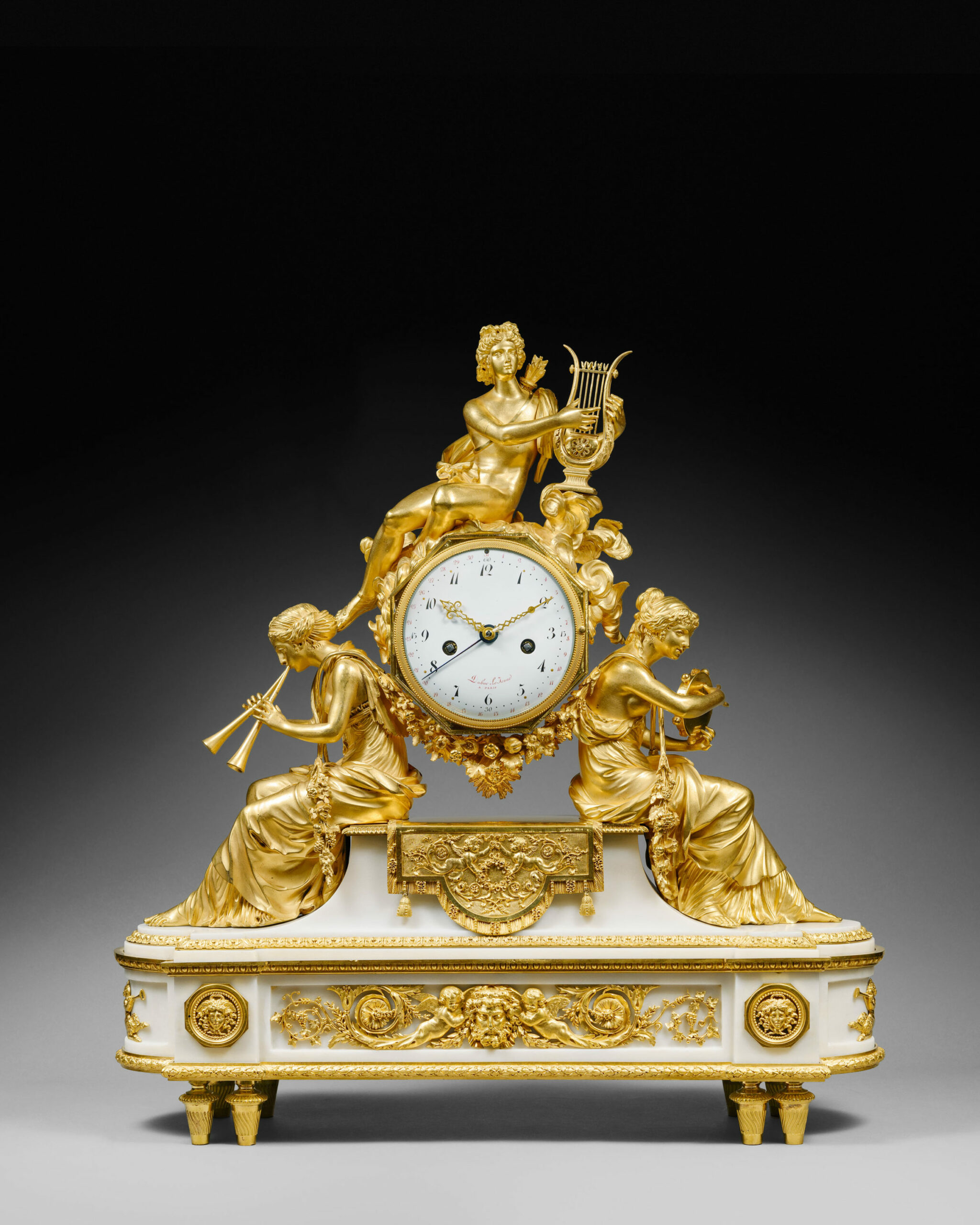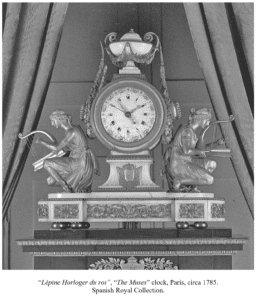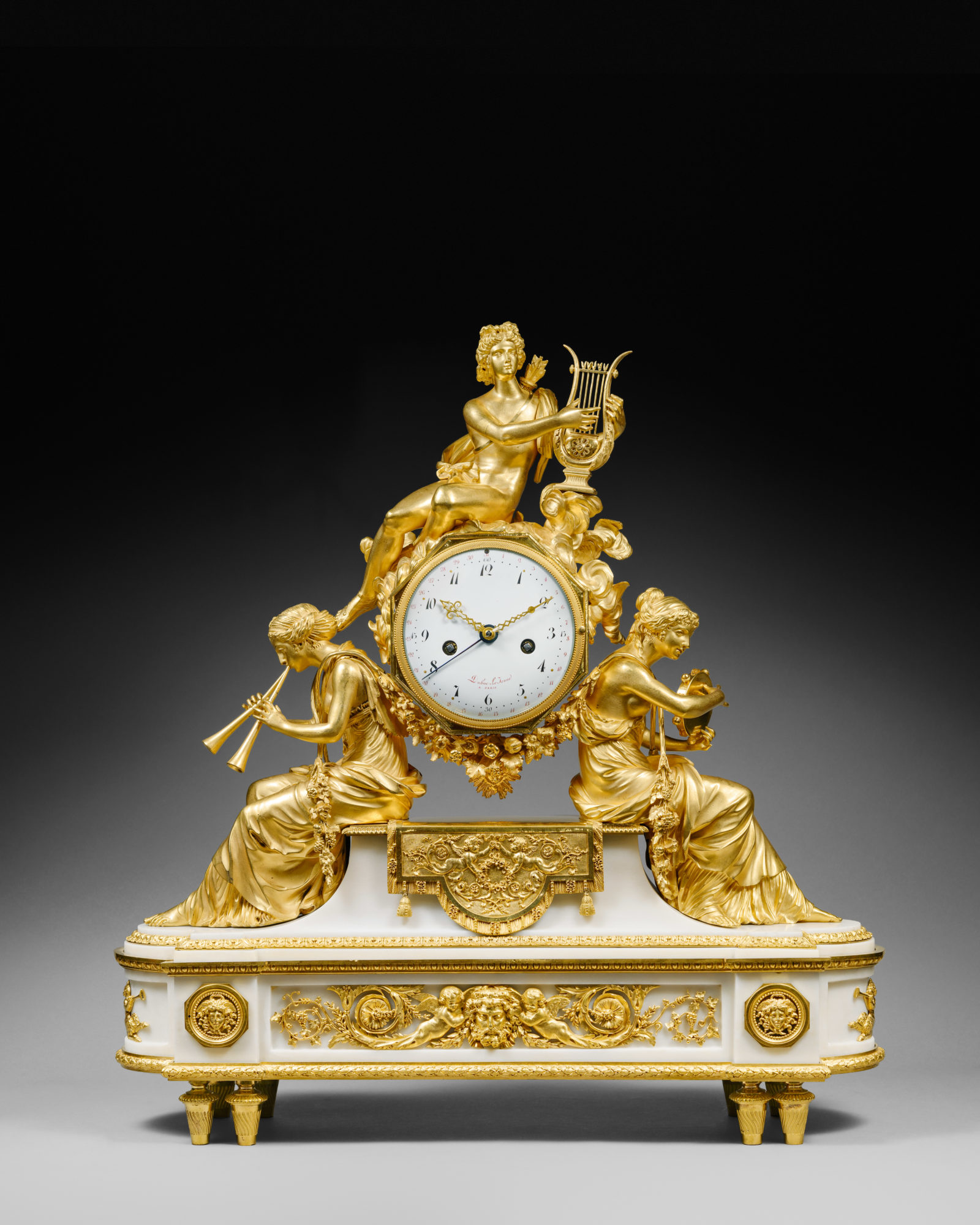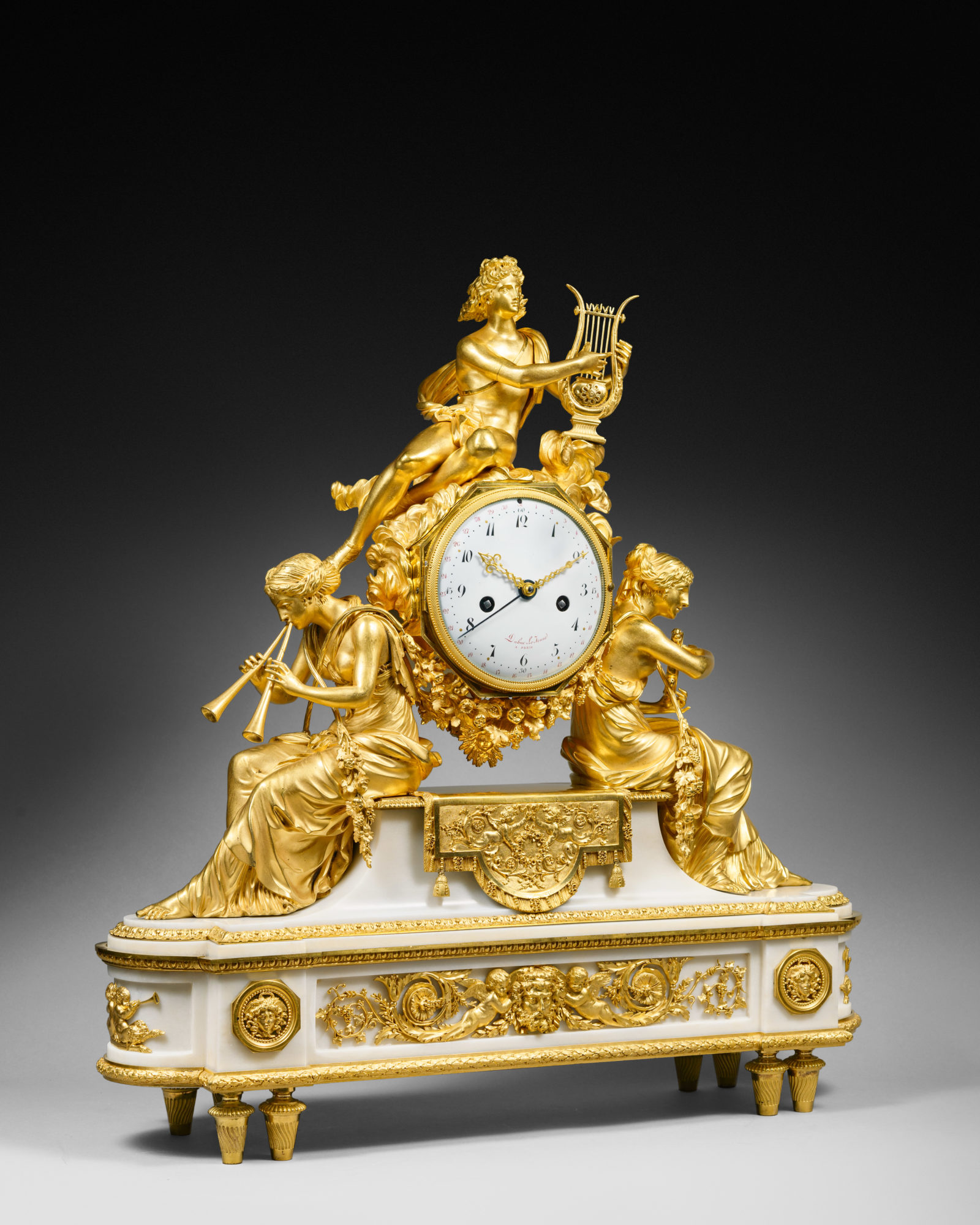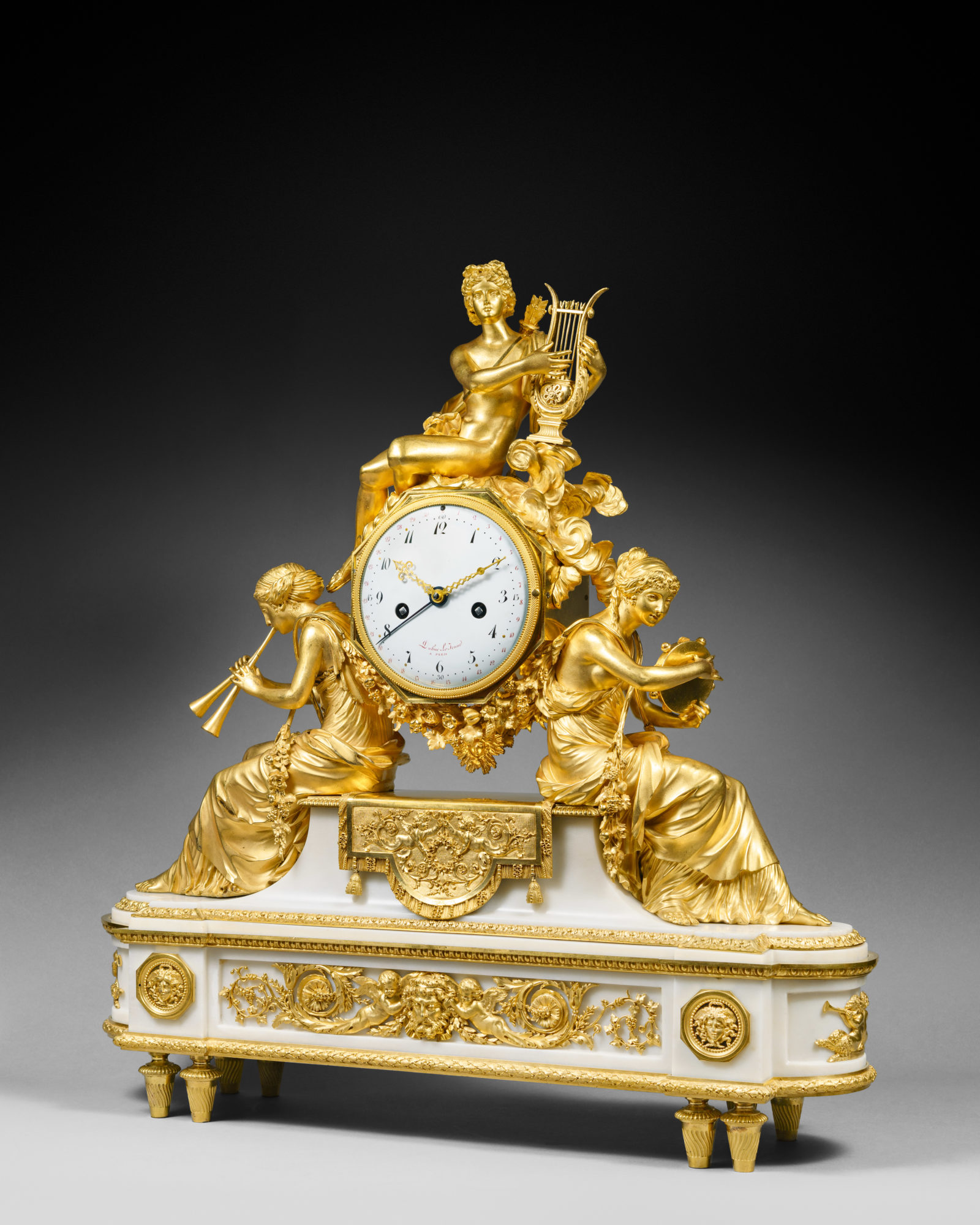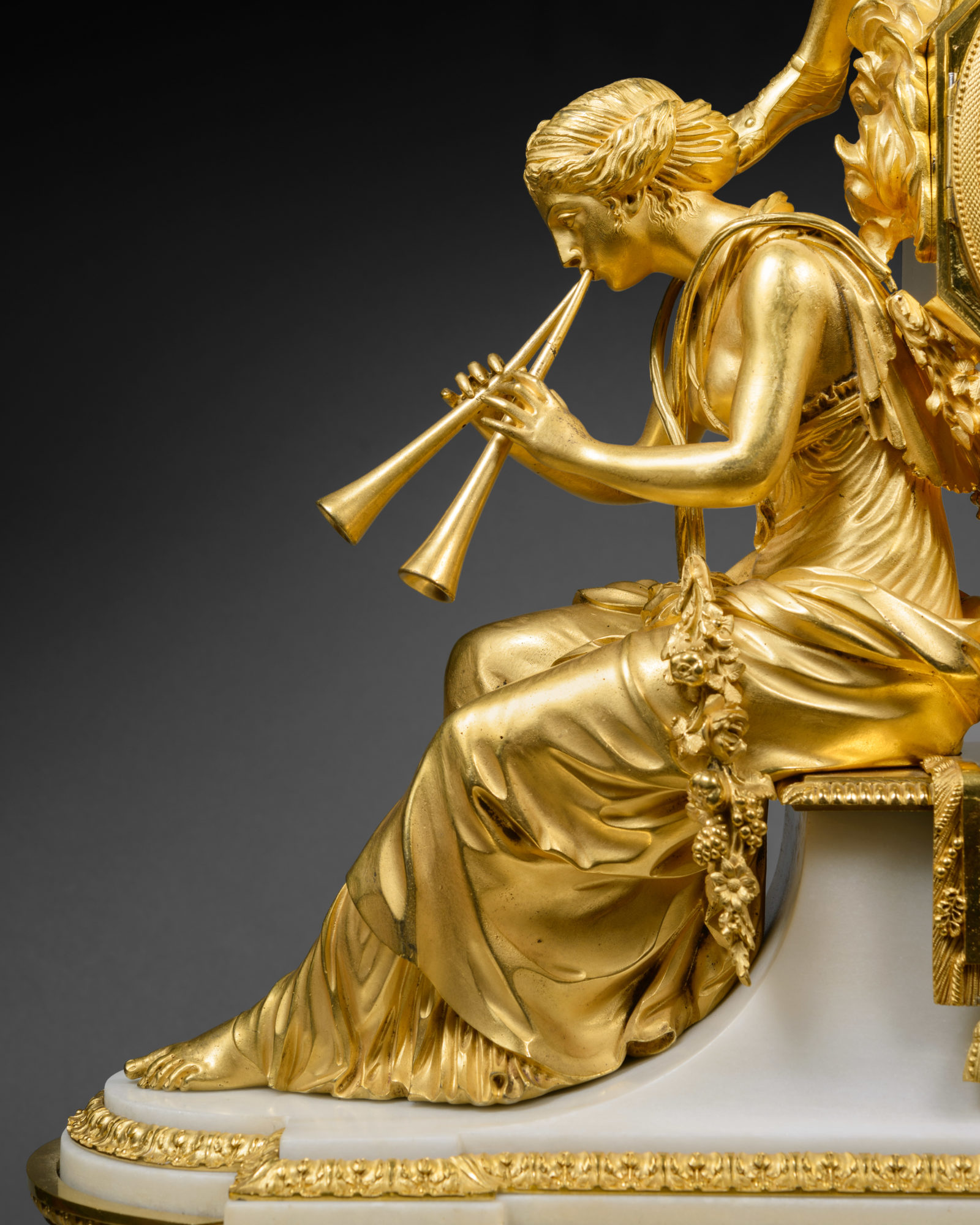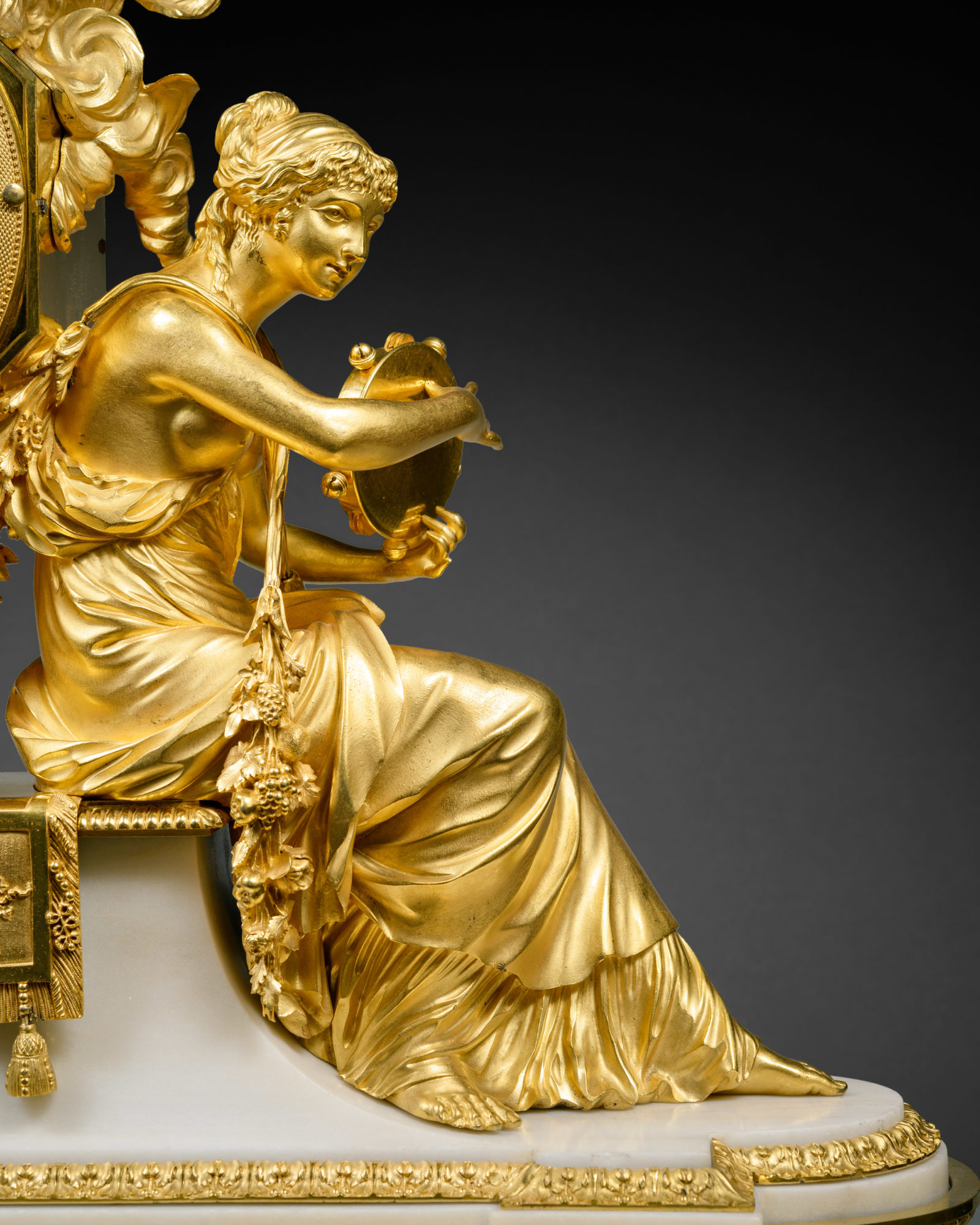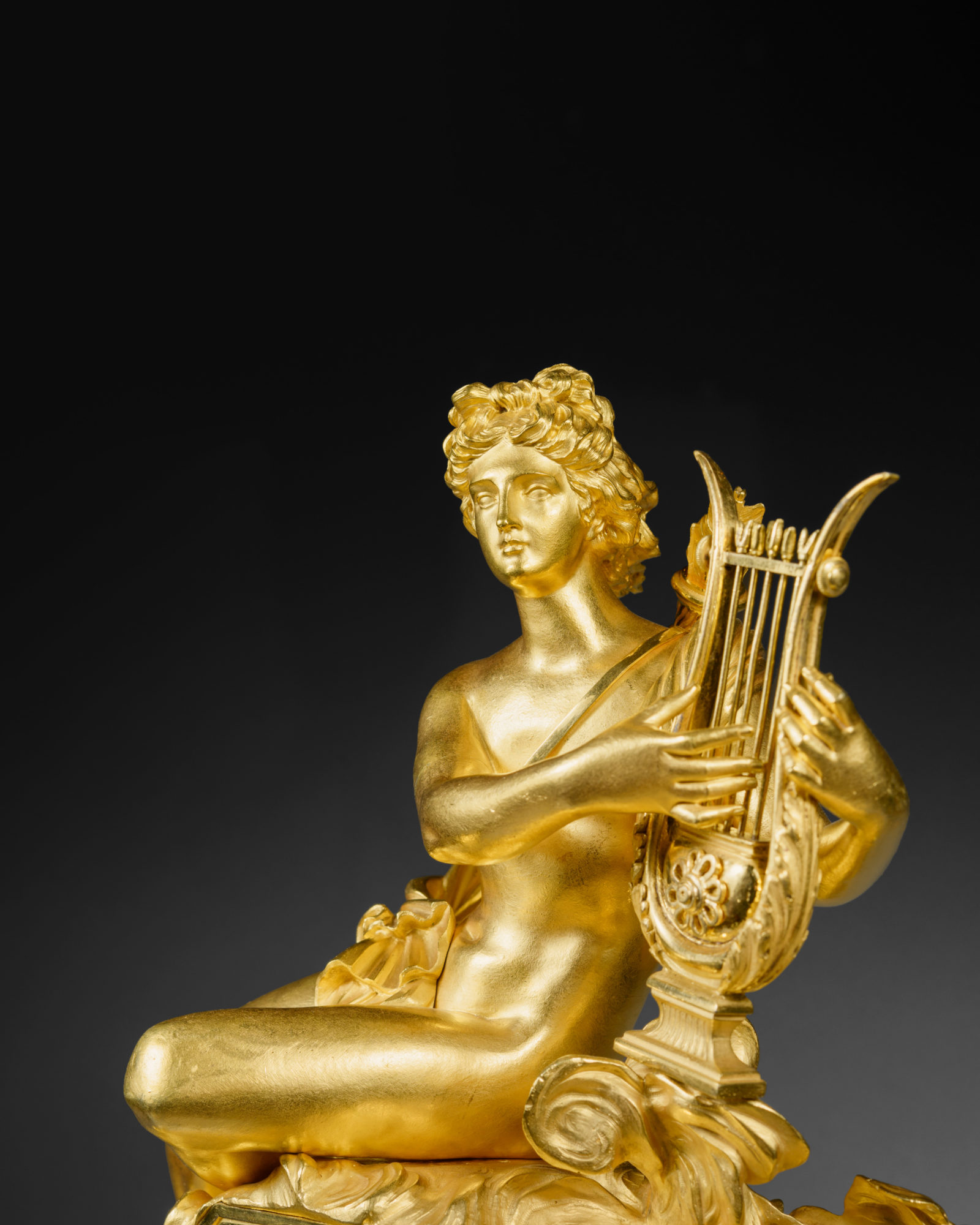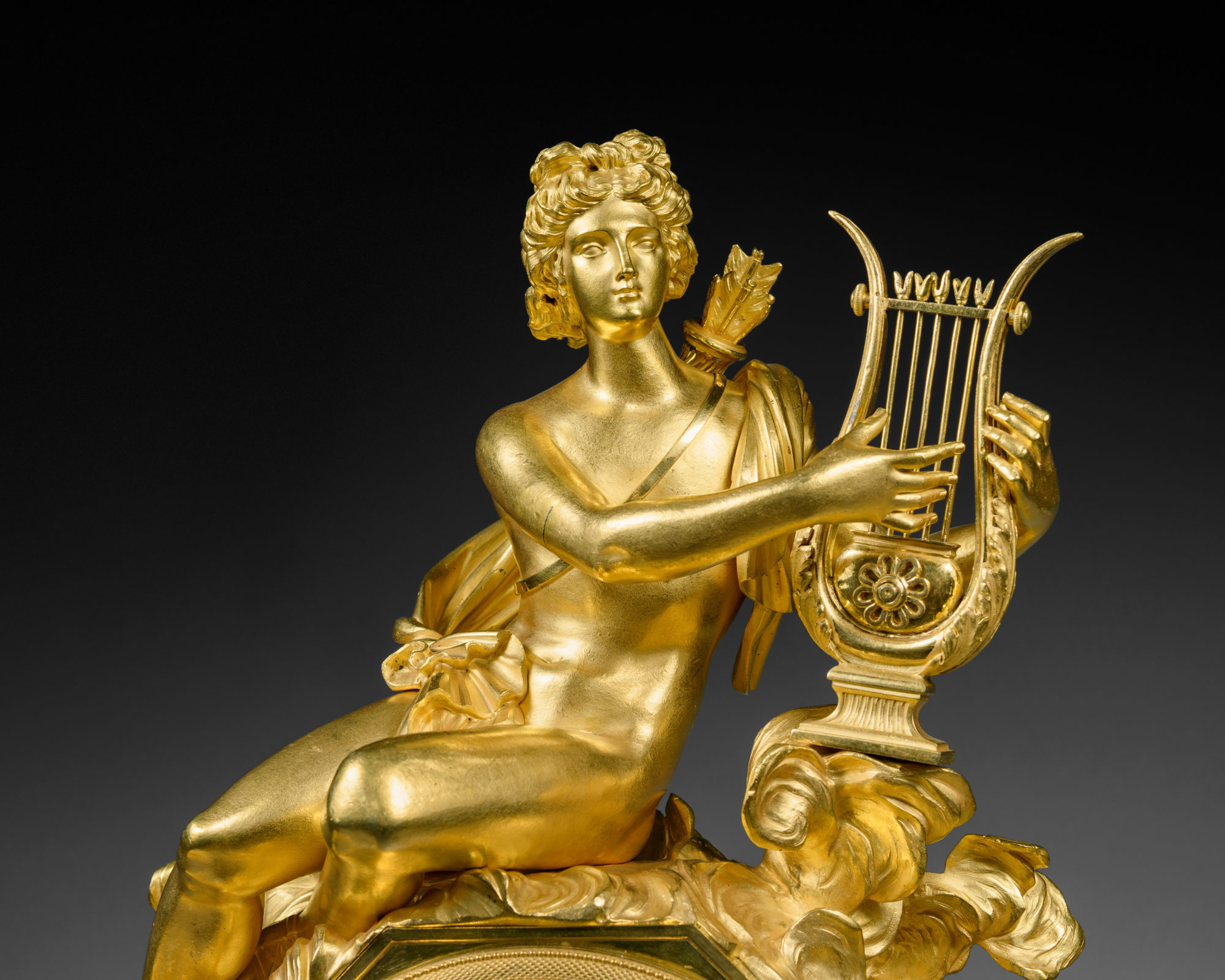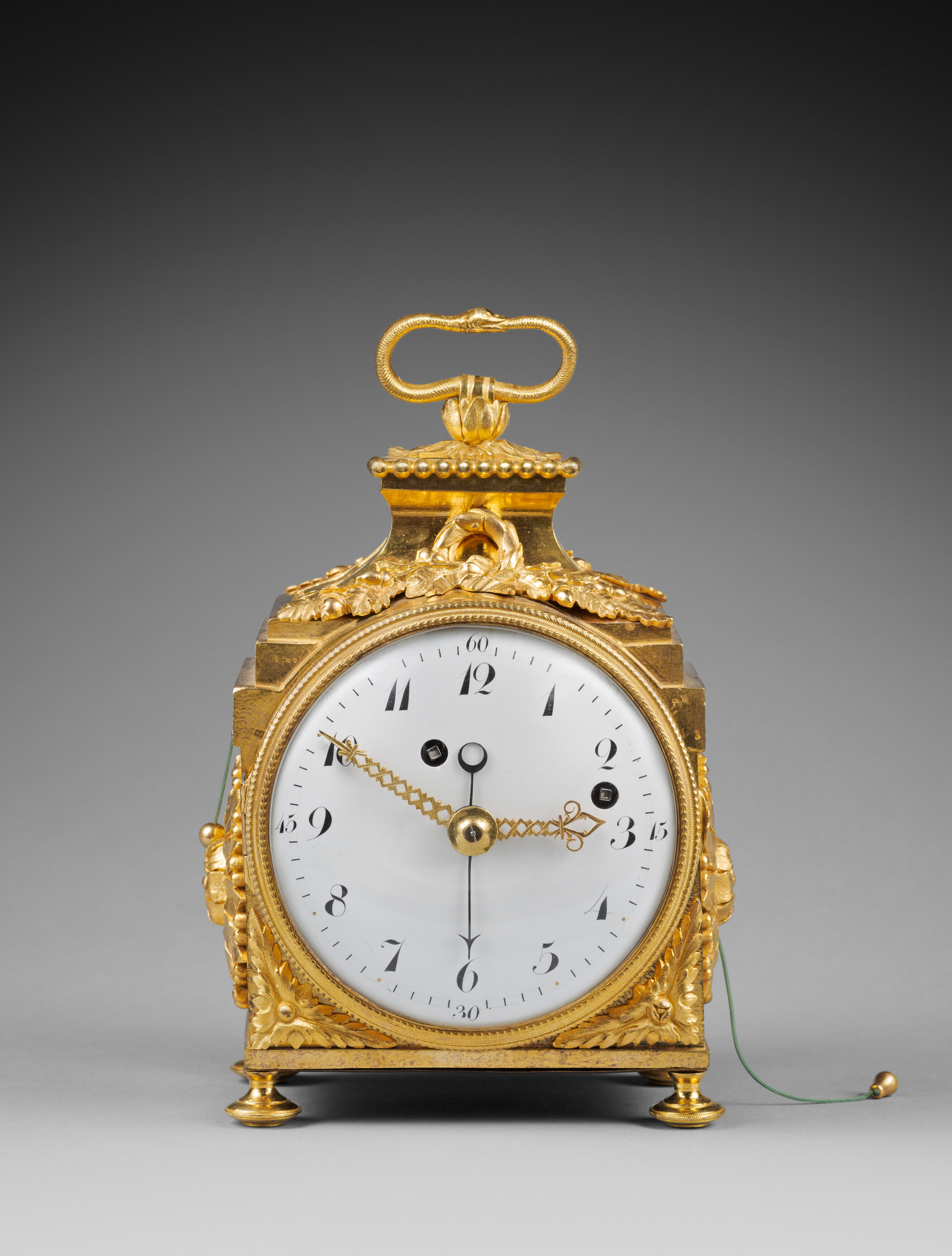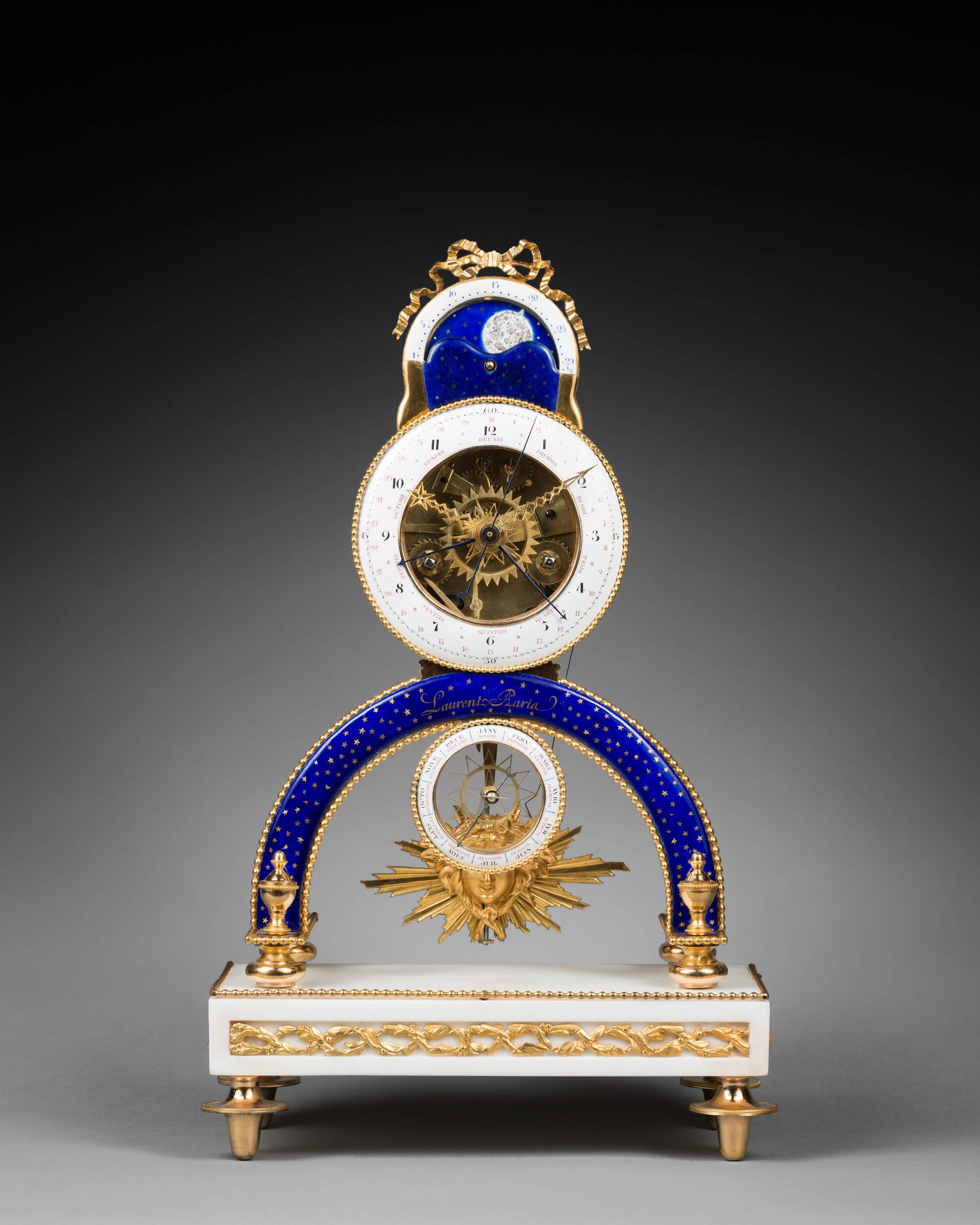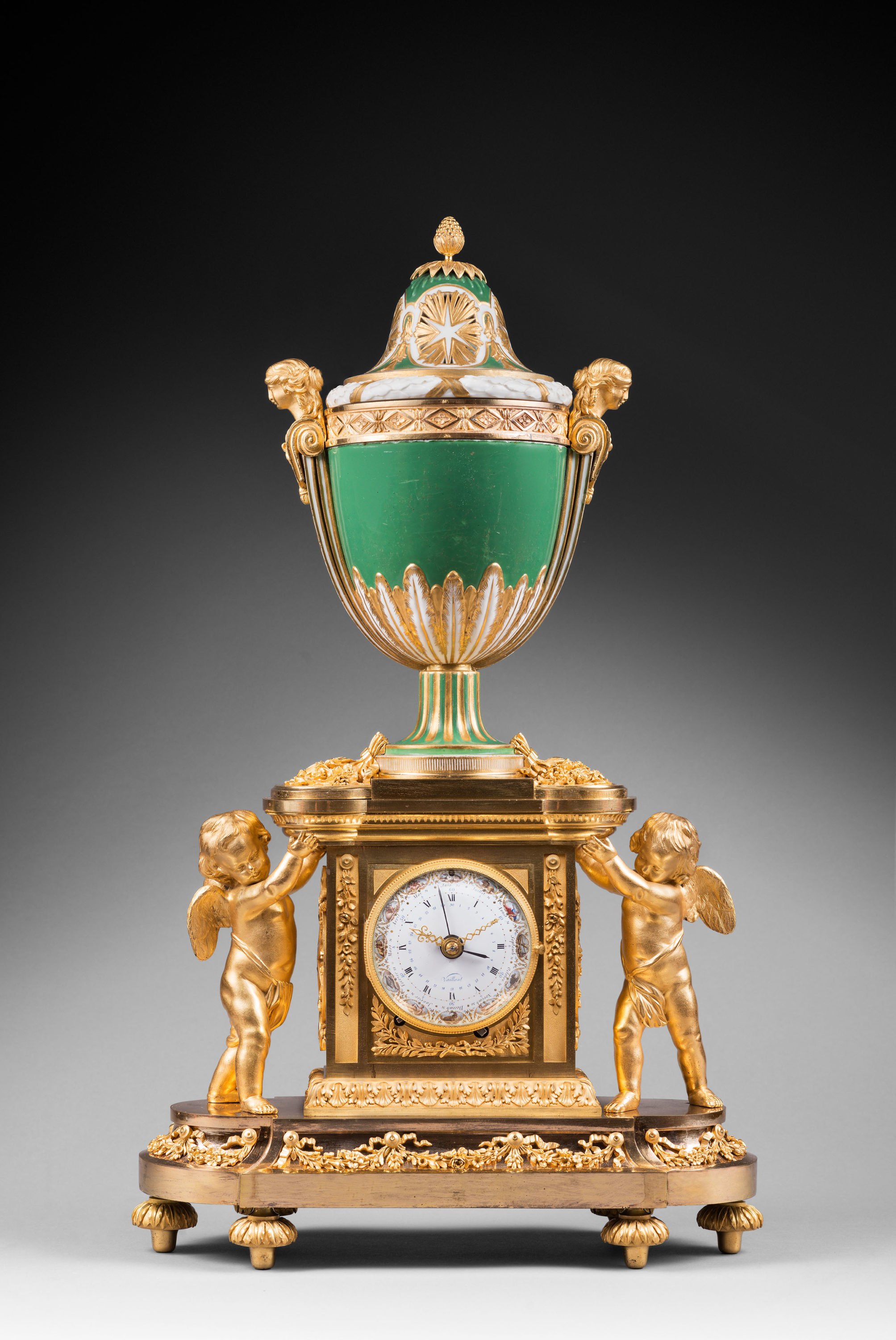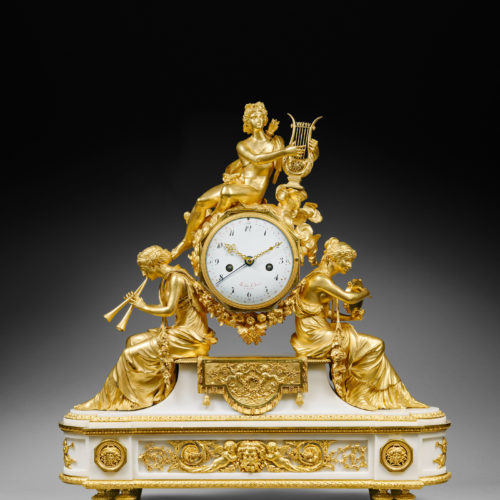Exceptional Neoclassical White Carrara Marble and Gilt Bronze Mantel Clock
“Apollo Citharoedus and the Muses”
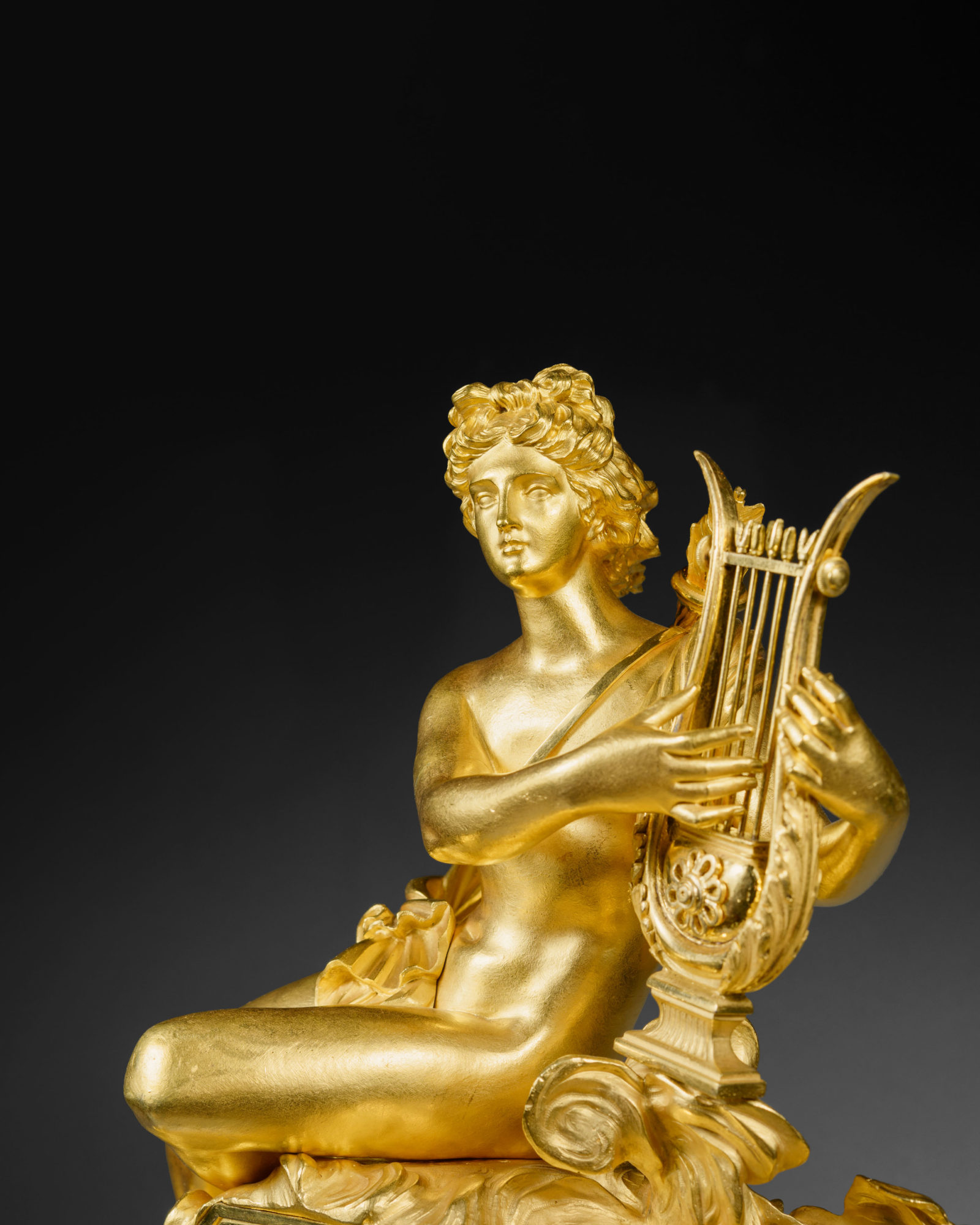
The Bronze Mounts attributed to François Rémond
Probably Made under the Supervision of Dominique Daguerre
Paris, Louis XVI period, circa 1785
The round white enamel dial, signed “Dubuc Le Jeune à Paris”, indicates the Arabic numeral hours, fifteen-minute intervals, and date by means of three hands, two of which are made of pierced gilt bronze, and a blued steel pointer. The magnificent gilt bronze and white marble neoclassical case features finely chased gilt bronze allegorical or mythological figures.
The engine-turned bezel is adorned with a bead frieze. The movement is housed in an octagonal case that is surmounted by the figure of Apollo playing the cithara (Apollo citharoedus). He is clad in light drapery and is wearing laced sandals; a quiver with feathers is slung across his chest. The god of harmony and balance, he is seated among clouds and is playing a five-stringed cithara whose sides are adorned with acanthus leaves. Flanking the dial, two female figures dressed in classical drapery are seated on an entablature with a fringed valance, ornamented with a flower, bead, and cord border; it is centered by two facing putti against a matted ground that terminate in scrolling with rosettes. The putti carry a ribbon-tied flower wreath. The female figures represent muses who with flower and leaf swags with bunches of grapes and pinecones slung over their shoulders. The first, who is playing a double flute, represents Euterpe, who brings joy and pleasure with her music. The second, playing the drum, represents Terpsichore, who spreads the joyous cadence of rhythm and dance.
The plinth, bordered by a frieze of stylized foliage, is supported on a quadrangular base with rounded corners that is adorned with egg and dart and seeded laurel torus friezes. It is ornamented with two satyr children playing instruments, masks of Mercury within medallions decorated with bead friezes, and winged children that terminate in scrolling arabesques supporting a bearded mask. The clock is raised on eight tapering feet that are chased with egg and dart friezes and diagonal fluting.
Discover our entire collection of antique mantel clocks for sale online or at the gallery.
La Pendulerie is the specialist in fine and rare antique clocks, based in Paris.
The large size of this clock, as well as the remarkable chasing and gilding of its bronze mounts and the sculptural treatment of its three mythological figures, set it apart from most other clocks made during the late Louis XVI period. It may be considered one of the masterpieces of late 18th century Parisian clockmaking. It was made by several of the finest artisans working in the field of the decorative arts at the time. Thus, while the dial is signed by the clockmaker Dubuc Le Jeune, the gilt bronze mounts, in which burnishing contrasts elegantly with matte areas, may be attributed to François Rémond (circa 1747-1812), one of the most important Parisian chaser-gilders of the last third of the 18th century. Rémond used the same mask and putti frieze on the famous “à l’étude” clock, which was sold by Daguerre beginning in 1784. An example of this clock is on display at the Musée national du Château de Versailles (see C. Baulez, “Les bronziers Gouthière, Thomire et Rémond”, in the exhibition catalogue Louis-Simon Boizot (1743-1809), sculpteur du roi et directeur de l’atelier de sculpture à la Manufacture de Sèvres, Musée Lambinet, Versailles, October 2001-February 2002, p. 287, fig. 9). The clock was almost certainly created under the supervision of the marchand-mercier Dominique Daguerre who, along with Martin-Eloi Lignereux, held a near monopoly on the commissions of luxury items and furnishings placed by influential Parisian collectors. To illustrate the extent of his activity, at the time of the Revolution, the list of debtors of Daguerre and Lignereux included Queen Marie-Antoinette, the Prince de Condé, the Count and Countess d’Artois, the queen’s close friend the princesse de Lamballe, Duke Philippe d’Orléans, and Madame Elizabeth, the sister of King Louis XVI.
Only a few similar clocks are known to exist. Among them, one example that is identical to the present clock, but of lesser quality, was formerly in the collection of a Spanish aristocrat and diplomat; it was offered on the French art market in 1989. A second clock, probably slightly later, with an allegorical theme relating to music, is in the Paris Musée des Arts décoratifs (illustrated in Tardy, La pendule française, 2ème Partie: Du Louis XVI à nos jours, Paris, 1975, p. 362). One further example, whose dial is signed “Lépine Horloger du Roi à Paris”, with two figures of muses playing musical instruments, is in the Royal Spanish Collection. Its excellent quality and rarity make it the only known example that is truly comparable to the present clock. (see J. Ramon Colon de Carvajal, Catalogo de Relojes del Patrimonio nacional, Madrid, 1987, p. 56, catalogue 39).
Jean-Baptiste-Gabriel Dubuc (? - before 1820)
Jean-Baptiste-Gabriel Dubuc, who signed “Dubuc le jeune”, was one of the most important Parisian horologists of the Consulate and Empire periods. His workshop, located in the rue des Gravilliers from 1800 to 1817, was very active, as can be seen from the probate inventories of important figures of the early 19th century. They mention the work of Dubuc le jeune as being found in the homes of influential aristocrats such as Charles-Marie-Philippe Huchet de la Bédoyère and Mlle de Clermont-Montoison, the widow of the Marquis de la Guiche, as well as several other dignitaries of the period. They were part of the collection of Senator Henry Fargues and that of André Masséna, the Prince of Essling and Duke de Rivoli.
François Rémond (circa 1747 - 1812)
Along with Pierre Gouthière, he was one of the most important Parisian chaser-gilders of the last third of the 18th century. He began his apprenticeship in 1763 and became a master chaser-gilder in 1774. His great talent quickly won him a wealthy clientele, including certain members of the Court. Through the marchand-mercier Dominique Daguerre, François Rémond was involved in furnishing the homes of most of the important collectors of the late 18th century, supplying them with exceptional clock cases, firedogs, and candelabra. These elegant and innovative pieces greatly contributed to his fame.
Dominique Daguerre is the most important marchand-mercier (i.e. merchant of luxury objects) of the last quarter of the 18th century. Little is known about the early years of his career; he appears to have begun to exercise his profession around 1772, the year he went into partnership with Philippe-Simon Poirier (1720-1785), the famous marchand-mercier who began using porcelain plaques from the Manufacture royale de Sèvres to adorn pieces of furniture. When Poirier retired around 1777-1778, Daguerre took over the shop in the rue du Faubourg Saint-Honoré, keeping the name “La Couronne d’Or”. He retained his predecessor’s clientele, and significantly increased the shop’s activity within just a few years. He played an important role in the renewal of the Parisian decorative arts, working with the finest cabinetmakers of the day, including Adam Weisweiler, Martin Carlin and Claude-Charles Saunier, cabinetmaker of the Garde-Meuble de la Couronne, Georges Jacob, the bronziers and chaser-gilders Pierre-Philippe Thomire and François Rémond, and the clockmaker Renacle-Nicolas Sotiau. A visionary merchant who brought the level of French luxury goods to its highest point, Daguerre settled in England in the early 1780’s, having gone into partnership with Martin-Eloi Lignereux, who remained in charge of the Paris shop. In London, where he enjoyed the patronage of the Prince Regent (the future King George IV), Daguerre actively participated in the furnishing and decoration of Carlton House and the Brighton Pavilion. Taking advantage of his extensive network of Parisian artisans, he imported most of the furniture, chairs, mantelpieces, bronze furnishings, and art objects from France, billing over 14500£, just for 1787. Impressed by Daguerre’s talent, several British aristocrats, called on his services as well. Count Spencer engaged him for the decoration of Althorp, where Daguerre worked alongside architect Henry Holland (1745-1806). In Paris, Daguerre and his partner Lignereux continued to supply influential connoisseurs and to deliver magnificent pieces of furniture to the Garde-Meuble de la Couronne, which were placed in the apartments of Louis XVI and Marie-Antoinette. Daguerre retired in 1793, no doubt deeply affected by the French Revolution and the loss of many of his most important clients.
